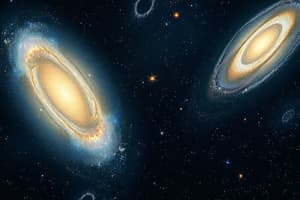Podcast
Questions and Answers
What are the four classes of galaxies according to the Hubble Classification Scheme?
What are the four classes of galaxies according to the Hubble Classification Scheme?
- Barred Spirals (correct)
- Irregulars (correct)
- Spirals (correct)
- Ellipticals (correct)
What characterizes spiral galaxies?
What characterizes spiral galaxies?
Twisted collections of stars and gas, often with beautiful shapes and hot young stars.
What is a barred-spiral galaxy?
What is a barred-spiral galaxy?
A spiral galaxy with a central bar-shaped structure composed of stars.
What is an elliptical galaxy?
What is an elliptical galaxy?
What is the definition of SBO galaxies?
What is the definition of SBO galaxies?
What are irregular galaxies?
What are irregular galaxies?
What are the Magellanic Clouds?
What are the Magellanic Clouds?
What are standard candles in astrophysics?
What are standard candles in astrophysics?
What does the Tully-Fisher relation describe?
What does the Tully-Fisher relation describe?
What is the Local Group?
What is the Local Group?
What is a galaxy cluster?
What is a galaxy cluster?
What does cosmologic redshift refer to?
What does cosmologic redshift refer to?
What is Hubble's constant represented by?
What is Hubble's constant represented by?
What are active galaxies?
What are active galaxies?
What are active galactic nuclei?
What are active galactic nuclei?
What distinguishes Seyfert galaxies?
What distinguishes Seyfert galaxies?
What is a galactic nucleus?
What is a galactic nucleus?
What are radio galaxies?
What are radio galaxies?
What are radio lobes?
What are radio lobes?
What is a blazar?
What is a blazar?
What are quasars?
What are quasars?
What is a quasi-stellar object?
What is a quasi-stellar object?
What is synchrotron radiation?
What is synchrotron radiation?
Flashcards are hidden until you start studying
Study Notes
Galaxy Classification
- Edwin Hubble's Classification Scheme categorizes galaxies into four primary types: spirals, barred spirals, ellipticals, and irregulars.
- Spiral galaxies feature distinctive winding structures and are predominantly composed of hot young stars; they are the most commonly observed galaxy type.
- Barred-spiral galaxies possess a central bar-shaped formation of stars, found in roughly half of all spiral galaxies.
Types of Galaxies
- Elliptical galaxies have an ellipsoidal shape and lack significant texture, presenting a smooth and featureless appearance.
- Irregular galaxies exhibit no regular shape, differing significantly from spirals and ellipticals.
- Lenticular galaxies (S0) are morphologically between elliptical and spiral galaxies, connecting E and S0 types.
Notable Galaxies
- The Magellanic Clouds are two irregular dwarf galaxies orbiting the Milky Way, visible in the Southern Hemisphere and part of the Local Group.
- Active galaxies emit energy at levels thousands of times greater than typical galaxies, with their centers—active galactic nuclei—showing much higher luminosity than normal stars.
Cosmic Relationships
- Standard candles, such as supernovae or variable stars, have known luminosities, making them critical for distance measurements in astrophysics.
- The Tully-Fisher relation links a spiral galaxy's mass or intrinsic luminosity with its rotational velocity, allowing for mass estimations based on rotation.
Galactic Structures
- The Local Group consists of over 50 galaxies, with the Milky Way being a member.
- Galaxy clusters contain hundreds to thousands of galaxies, bound by gravity and typically ranging in mass from 10¹⁴ to 10¹⁵ solar masses.
Cosmic Phenomena
- Cosmological redshift describes the increase in wavelength of electromagnetic radiation, signaling the expansion of the universe.
- Hubble's constant defines the relationship between the velocity of a galaxy's recession and its distance from us.
Active Galaxy Types
- Seyfert galaxies are a prominent group of active galaxies known for high luminosity and are one of the two largest classifications alongside quasars.
- Radio galaxies are distinguished by their luminosity at radio wavelengths, attributed to the synchrotron process.
- Blazars are a specific type of active galactic nucleus characterized by a relativistic jet directed towards Earth.
High-Energy Astronomical Objects
- Quasars are extraordinarily bright active galactic nuclei powered by supermassive black holes, with masses from millions to billions of solar masses surrounded by an accretion disk.
- Quasi-stellar objects refer to extremely luminous active galactic nuclei, signaling the early stages of galaxy formation.
Emission Mechanisms
- Synchrotron radiation is electromagnetic energy released when charged particles accelerate radially, often seen in active galaxies.
Studying That Suits You
Use AI to generate personalized quizzes and flashcards to suit your learning preferences.



